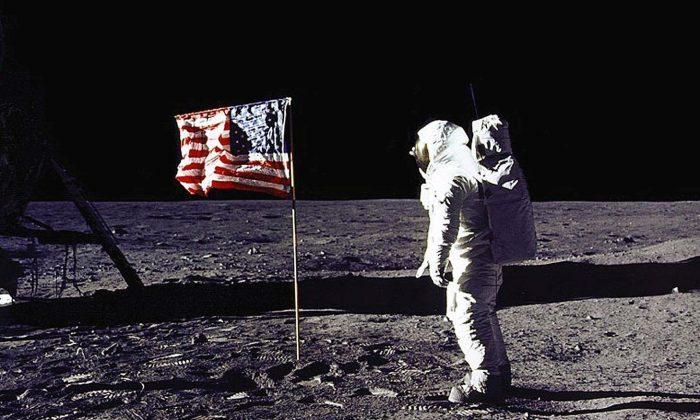There they are!
Our American Apollo 11 astronauts gliding across the Sea of Tranquility on our moon.
I’m among the billions around the world on July 20, 1969, viewing televised pictures from the moon. It is stunningly thrilling and mesmerizing. A feat not even science fiction novelist Jules Verne, author of the 1865 novel “From Earth to the Moon,” could have envisioned. Yet, here I am experiencing this heart-thumping wonder as it happens.
Moon Landing
Watching the moon landing, we see launch commander Neil Armstrong and lunar module pilot Edwin “Buzz” Aldrin, on the wings of brilliant design, devotion, and the dedication of thousands, as they seem to effortlessly float to place the U.S. flag on the lunar surface. As command module pilot Michael Collins keeps watch, circling above them, they install a stainless steel plaque inscribed: “Here men from the planet Earth first set foot upon the moon. July 1969, A.D. We came in peace for all mankind.” Armstrong had a fragment of the Wright brothers’ fabric aircraft—on the moon. A relic of America’s striving. One can only wish the brothers could know.The billions of humans across the planet were caught up in the drama of the lunar expedition, in the spirit of American pioneering.
There was a sense of great connection, witnessing the courageous Americans on the moon we could see, as well as those enterprising creators who we could not. All worked in cooperation to achieve a spectacular goal: Putting a man on the moon and returning him safely to Earth.
A friend’s husband worked as a design engineer in California for the space program, as did my son’s father-in-law, a retired U.S. Air Force colonel. There is a sense of quiet pride in serving their country for such people of talent. Now in their 80s, my friends told me they plan to attend the Rose Bowl Apollo 11 commemoration. These were some of the people who had persevered to reach the goals articulated by then-President John F. Kennedy in his famous speech at Rice University in Houston, on Sept. 12, 1962.
“We choose to go to the moon,” JFK declared, illuminating the American ethos of bravery and imagination.
The choice and freedom to strive is what makes America the beacon it has been to the world.
This fired the nation’s resolve and energies—thousands of engineers, designers, and metalworkers—to undertake “the most hazardous and dangerous and greatest adventure on which man has ever embarked,” JFK said.
And it happened only 42 years after 25-year-old Charles Lindbergh flew his little cloth-covered “Spirit of St. Louis” airplane across the Atlantic Ocean from the United States, landing in Paris, on May 21, 1927. It’s truly breathtaking to contemplate.
I once visited a factory where a space ship nose cone was being fabricated, and also a foundry where well-designed parts were made for the space program. Thousands of talented people worked diligently to make the lunar expedition possible. The hardships of the space program included the loss of too many.
The disasters of the Columbia in 2003; the Challenger in 1986; and the shocking fire of Apollo 1 in 1967, which killed astronauts Edward White, Gus Grissom, and Roger Chaffee; all are mourned. The moon astronauts honored everyone who had made the lunar landing a success by their humble public demeanor.
“I still vividly recall standing with Neil, ” wrote Aldrin, “on the barren desolate, yet beautiful surface of the moon, looking at the small, brilliant-blue planet Earth, ... as virtually the entire world took that journey with us.”
Yes, we did take that journey, and it was sublime.
Aldrin took part in a program at the Richard Nixon Presidential Library & Museum in Yorba Linda, California. I made it a point to go specifically to see a real American astronaut in person. It’s a treasured experience. The Nixon museum has a fine Apollo 11 exhibit, as Richard Nixon was president at the time of the lunar landing. Videos of Nixon making a very long-distance phone call to the moon to congratulate the space program showed a president as tickled by the astronauts as the rest of us were.
The three American astronauts’ 195-hour journey to the moon and back plays as grand opera in the soundtrack of millions of minds around the world. “We few, we happy few, we band of brothers” who were alive to witness this great event when men walked upon the moon, is indelibly imprinted on our hearts. It was spectacular—yet, at once endearing and heartfelt.
A marvelous hallmark of the intelligence, imagination, and determination of the American spirit.



Friends Read Free